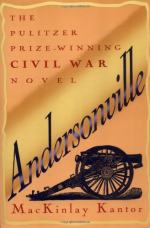the inner Stockade should at any time be forced by
the prisoners, the second forms another line of defense;
while in case of an attempt to deliver the prisoners
by a force operating upon the exterior, the outer
line forms an admirable protection to the Confederate
troops, and a most formidable obstacle to cavalry or
infantry. The four angles of the outer line are
strengthened by earthworks upon commanding eminences,
from which the cannon, in case of an outbreak among
the prisoners, may sweep the entire enclosure; and
it was designed to connect these works by a line of
rifle pits, running zig-zag, around the outer Stockade;
those rifle pits have never been completed.
The ground enclosed by the innermost Stockade lies
in the form of a parallelogram, the larger diameter
running almost due north and south. This space
includes the northern and southern opposing sides of
two hills, between which a stream of water runs from
west to east. The surface soil of these hills
is composed chiefly of sand with varying admixtures
of clay and oxide of iron. The clay is sufficiently
tenacious to give a considerable degree of consistency
to the soil. The internal structure of the hills,
as revealed by the deep wells, is similar to that
already described. The alternate layers of clay
and sand, as well as the oxide of iron, which forms
in its various combinations a cement to the sand,
allow of extensive tunneling. The prisoners not
only constructed numerous dirt huts with balls of
clay and sand, taken from the wells which they have
excavated all over those hills, but they have also,
in some cases, tunneled extensively from these wells.
The lower portions of these hills, bordering on the
stream, are wet and boggy from the constant oozing
of water. The Stockade was built originally to
accommodate only ten thousand prisoners, and included
at first seventeen acres. Near the close of
the month of June the area was enlarged by the addition
of ten acres. The ground added was situated
on the northern slope of the largest hill.
The average number of square feet of ground to each
prisoner in August 1864: 35.7
Within the circumscribed area of the Stockade the
Federal prisoners were compelled to perform all the
offices of life—cooking, washing, the calls
of nature, exercise, and sleeping. During the
month of March the prison was less crowded than at
any subsequent time, and then the average space of
ground to each prisoner was only 98.7 feet, or less
than seven square yards. The Federal prisoners
were gathered from all parts of the Confederate States
east of the Mississippi, and crowded into the confined
space, until in the month of June the average number
of square feet of ground to each prisoner was only
33.2 or less than four square yards. These figures
represent the condition of the Stockade in a better
light even than it really was; for a considerable
breadth of land along the stream, flowing from west
to east between the hills, was low and boggy, and




